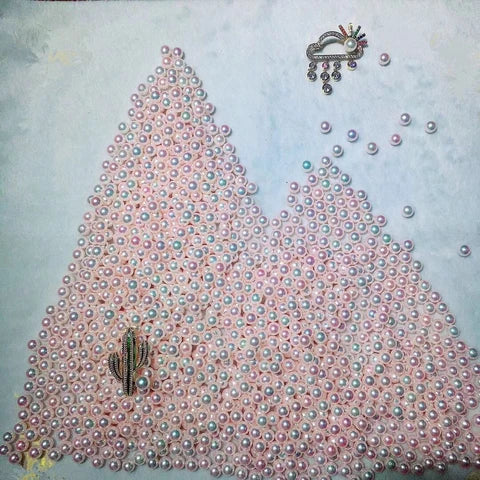As the birthstone of June, the pearl has the reputation of “Queen of Gems”, The warm and soft light of the pearls has caused countless women to dump it. However, there are some fake and inferior pearls on the market today. In order to prevent being deceived, there are several fairly simple methods to help you identify the true and false pearls and buy satisfactory pearl jewelry.
⭐ABS Plastic Imitation Pearls
ABS resin is one of the five synthetic resins with excellent impact resistance, heat resistance, low temperature resistance and electrical properties. It is also easy to process and has good surface gloss, they are easy to apply coloring and peel. ABS resin pearl is the cheapest of artificial pearls and it is not durable. All of generic plastic beads are colorful.

⭐Coated Glass Pearls
Glass pearls are round beads made of glass embryos. They are usually covered with a layer of pearlescent paint. The color of the paint can also be colorful. Gloss is better than plastic pearls, but the beads will flake off in layers if rub the pearls against each other or suffer any damage from minor impacts.

⭐Shell Pearls
One is the shell powder pressed and rolled, it is easier to molding than natural pearls because of artificially made. The other is casting polishing natural sea shells. Beads are generally used to make large pendants. They are round and large in diameter and generally over 12 mm. But it is easy to identification even imitation of a natural pearl. The shell beads are covered with a transparent membrane, which cannot be seen, when you throw it to the ground or use scrape with a knife, the film will be destroyed and exposed. It's like we puncture a transparent plastic bag.

The simplest method for identifying true and false pearls:
1. The first commonality of the fake pearls is that they are made of molds, they look perfectly spherical, they have the same amount of luster on every part of the surface, and show no indents or imperfections. Real pearls are only rarely "perfect". Usually, they'll have small blemishes or irregularities in their shape.
2. Simulated fake pearls are very uniform in thick color. Because it is spray painted or dyed. True pearls will have a small amount of color difference, the subtle color that is visible on their outer surface when light hits them. Fake pearls will usually not have this overtone effect, which is tricky to duplicate.
3. Simulated pearls have a smooth surface without flaws and texture, light weight. When touched real pearl you should feel noticeably cool for a few seconds. Rub the two pearls against each other with your hand. The real pearls feel resistance and make a "rustle" sound, while the fake pearls slip like glass balls.
4:Scraping on the synthetic coated beads will scrape up a film, that is glass real features. Scratch on the uncoated glass bead, only smooth feeling. A real pearl almost always has a clear outer nacre layer, while fake pearls have thin layers of artificial nacre or lack them entirely. You can check for nacre by peering in with a ten-fold magnifying glass. Real pearls will usually (but not always) have a noticeable line that separates the nacre from the nucleus (the inside part of the pearl).
Don't ignore common sense instincts about a pearl's price. The price of a real pearl will vary greatly based on its size, shape, overtone, and other features. However, they will never be outright cheap. For instance, a necklace made from freshwater pearls (the cheapest variety of real pearls) can easily retail for several hundred dollars. If a seller is giving you a deal on a set of real pearls that seems too good to be true, it probably is.
1 comment
- Choosing a selection results in a full page refresh.
- Press the space key then arrow keys to make a selection.
- Use left/right arrows to navigate the slideshow or swipe left/right if using a mobile device





Great article thanks for sharing.
Leave a comment